Analysis of Unilever's Internal Resources, External Environment and Competitive Position
VerifiedAdded on 2023/06/17
|12
|2663
|64
AI Summary
This report analyzes Unilever's internal resources and capabilities through VRIO analysis, SWOT analysis, and evaluates key drivers of change in the external environment through PESTLE analysis. It also uses Porter's five forces model to evaluate the competitive position of Unilever in the market.
Contribute Materials
Your contribution can guide someone’s learning journey. Share your
documents today.
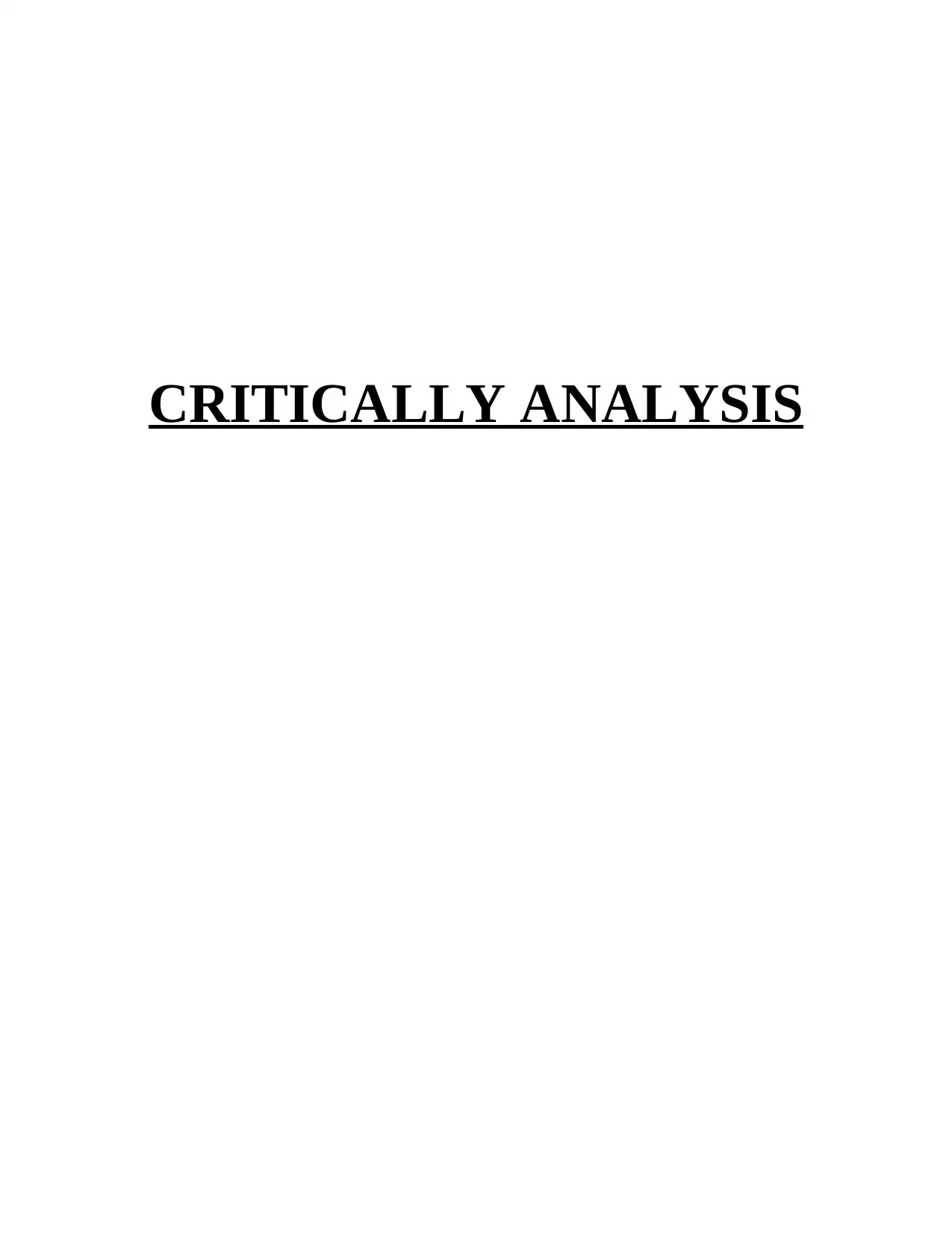
CRITICALLY ANALYSIS
Secure Best Marks with AI Grader
Need help grading? Try our AI Grader for instant feedback on your assignments.
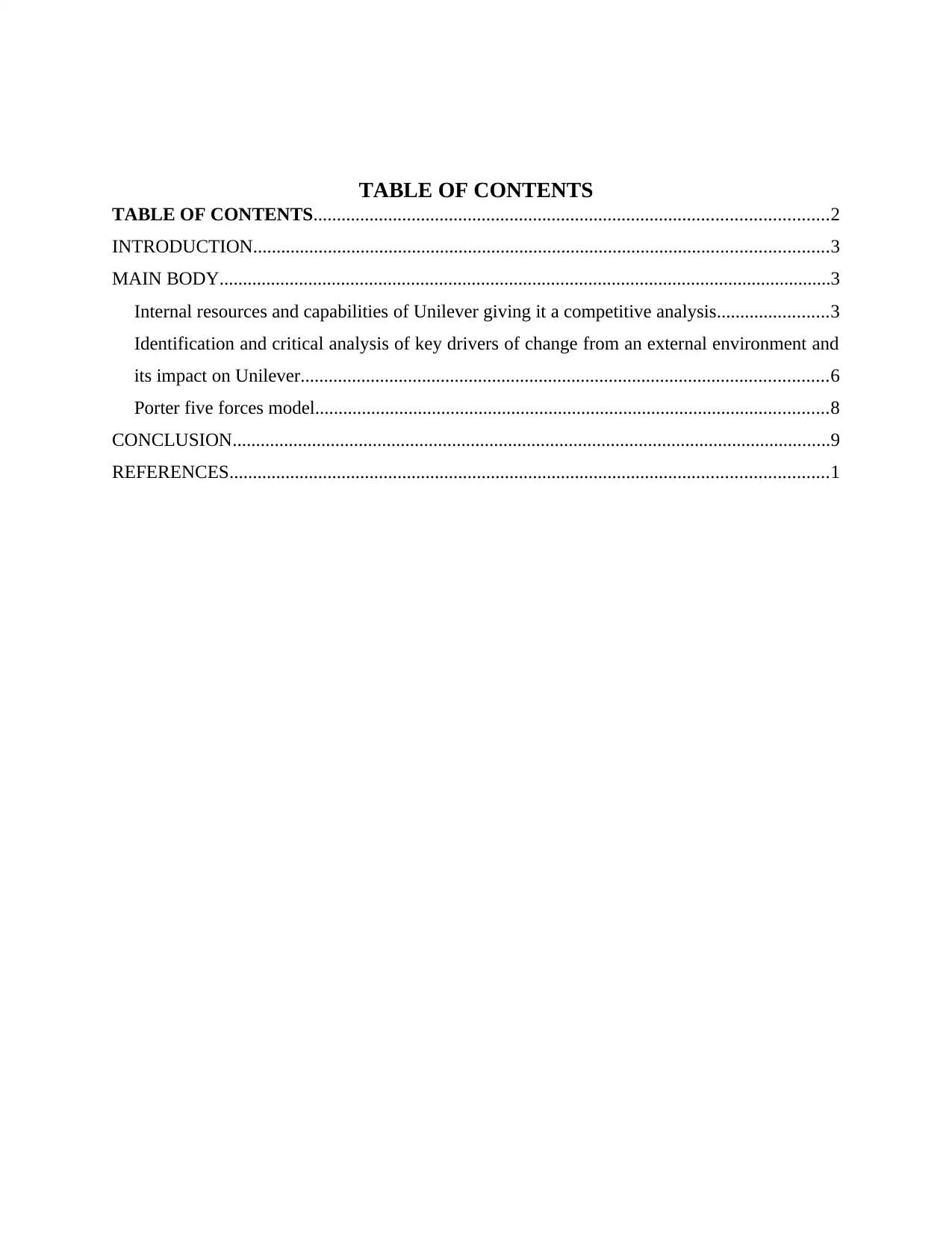
TABLE OF CONTENTS
TABLE OF CONTENTS..............................................................................................................2
INTRODUCTION...........................................................................................................................3
MAIN BODY...................................................................................................................................3
Internal resources and capabilities of Unilever giving it a competitive analysis........................3
Identification and critical analysis of key drivers of change from an external environment and
its impact on Unilever.................................................................................................................6
Porter five forces model..............................................................................................................8
CONCLUSION................................................................................................................................9
REFERENCES................................................................................................................................1
TABLE OF CONTENTS..............................................................................................................2
INTRODUCTION...........................................................................................................................3
MAIN BODY...................................................................................................................................3
Internal resources and capabilities of Unilever giving it a competitive analysis........................3
Identification and critical analysis of key drivers of change from an external environment and
its impact on Unilever.................................................................................................................6
Porter five forces model..............................................................................................................8
CONCLUSION................................................................................................................................9
REFERENCES................................................................................................................................1
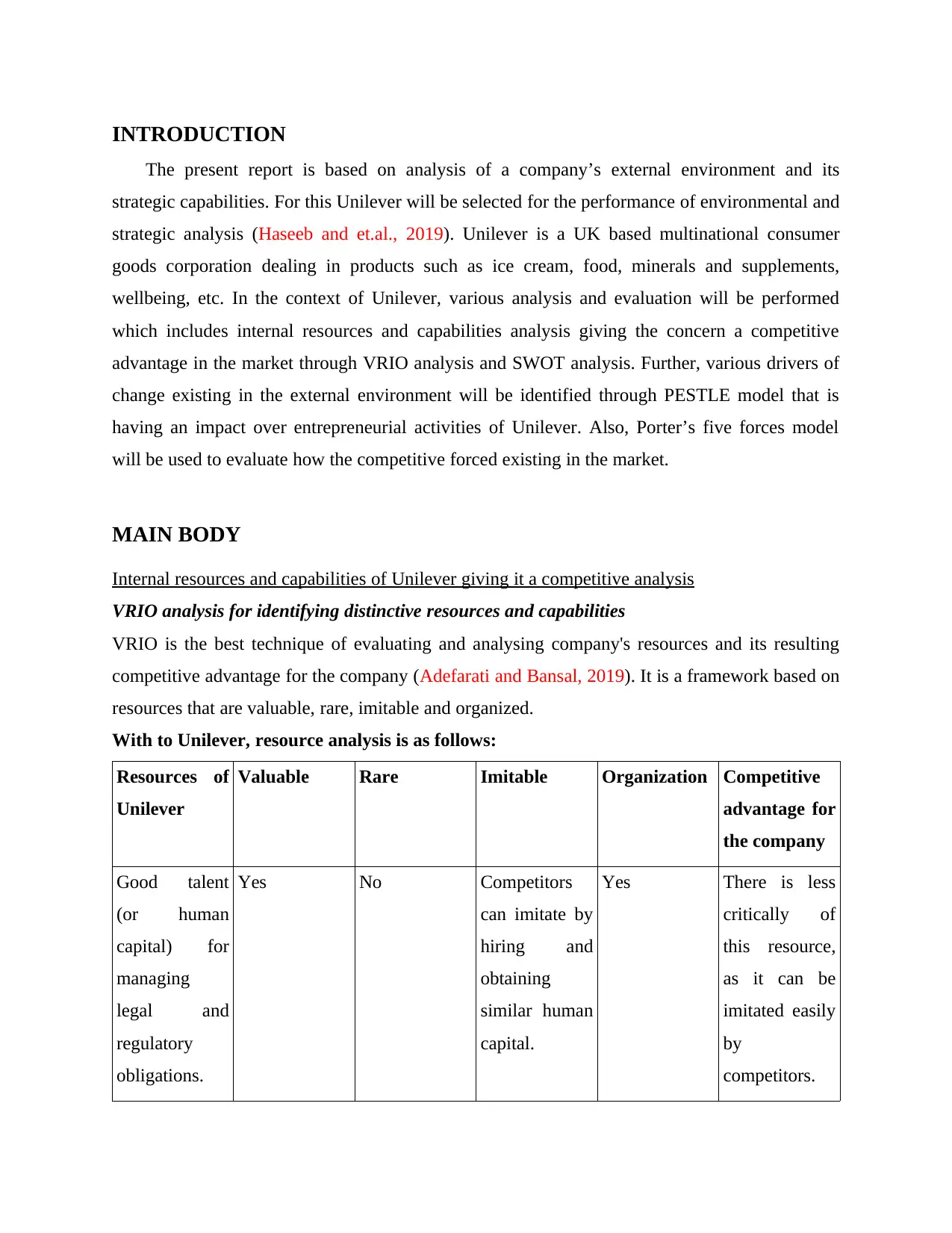
INTRODUCTION
The present report is based on analysis of a company’s external environment and its
strategic capabilities. For this Unilever will be selected for the performance of environmental and
strategic analysis (Haseeb and et.al., 2019). Unilever is a UK based multinational consumer
goods corporation dealing in products such as ice cream, food, minerals and supplements,
wellbeing, etc. In the context of Unilever, various analysis and evaluation will be performed
which includes internal resources and capabilities analysis giving the concern a competitive
advantage in the market through VRIO analysis and SWOT analysis. Further, various drivers of
change existing in the external environment will be identified through PESTLE model that is
having an impact over entrepreneurial activities of Unilever. Also, Porter’s five forces model
will be used to evaluate how the competitive forced existing in the market.
MAIN BODY
Internal resources and capabilities of Unilever giving it a competitive analysis
VRIO analysis for identifying distinctive resources and capabilities
VRIO is the best technique of evaluating and analysing company's resources and its resulting
competitive advantage for the company (Adefarati and Bansal, 2019). It is a framework based on
resources that are valuable, rare, imitable and organized.
With to Unilever, resource analysis is as follows:
Resources of
Unilever
Valuable Rare Imitable Organization Competitive
advantage for
the company
Good talent
(or human
capital) for
managing
legal and
regulatory
obligations.
Yes No Competitors
can imitate by
hiring and
obtaining
similar human
capital.
Yes There is less
critically of
this resource,
as it can be
imitated easily
by
competitors.
The present report is based on analysis of a company’s external environment and its
strategic capabilities. For this Unilever will be selected for the performance of environmental and
strategic analysis (Haseeb and et.al., 2019). Unilever is a UK based multinational consumer
goods corporation dealing in products such as ice cream, food, minerals and supplements,
wellbeing, etc. In the context of Unilever, various analysis and evaluation will be performed
which includes internal resources and capabilities analysis giving the concern a competitive
advantage in the market through VRIO analysis and SWOT analysis. Further, various drivers of
change existing in the external environment will be identified through PESTLE model that is
having an impact over entrepreneurial activities of Unilever. Also, Porter’s five forces model
will be used to evaluate how the competitive forced existing in the market.
MAIN BODY
Internal resources and capabilities of Unilever giving it a competitive analysis
VRIO analysis for identifying distinctive resources and capabilities
VRIO is the best technique of evaluating and analysing company's resources and its resulting
competitive advantage for the company (Adefarati and Bansal, 2019). It is a framework based on
resources that are valuable, rare, imitable and organized.
With to Unilever, resource analysis is as follows:
Resources of
Unilever
Valuable Rare Imitable Organization Competitive
advantage for
the company
Good talent
(or human
capital) for
managing
legal and
regulatory
obligations.
Yes No Competitors
can imitate by
hiring and
obtaining
similar human
capital.
Yes There is less
critically of
this resource,
as it can be
imitated easily
by
competitors.
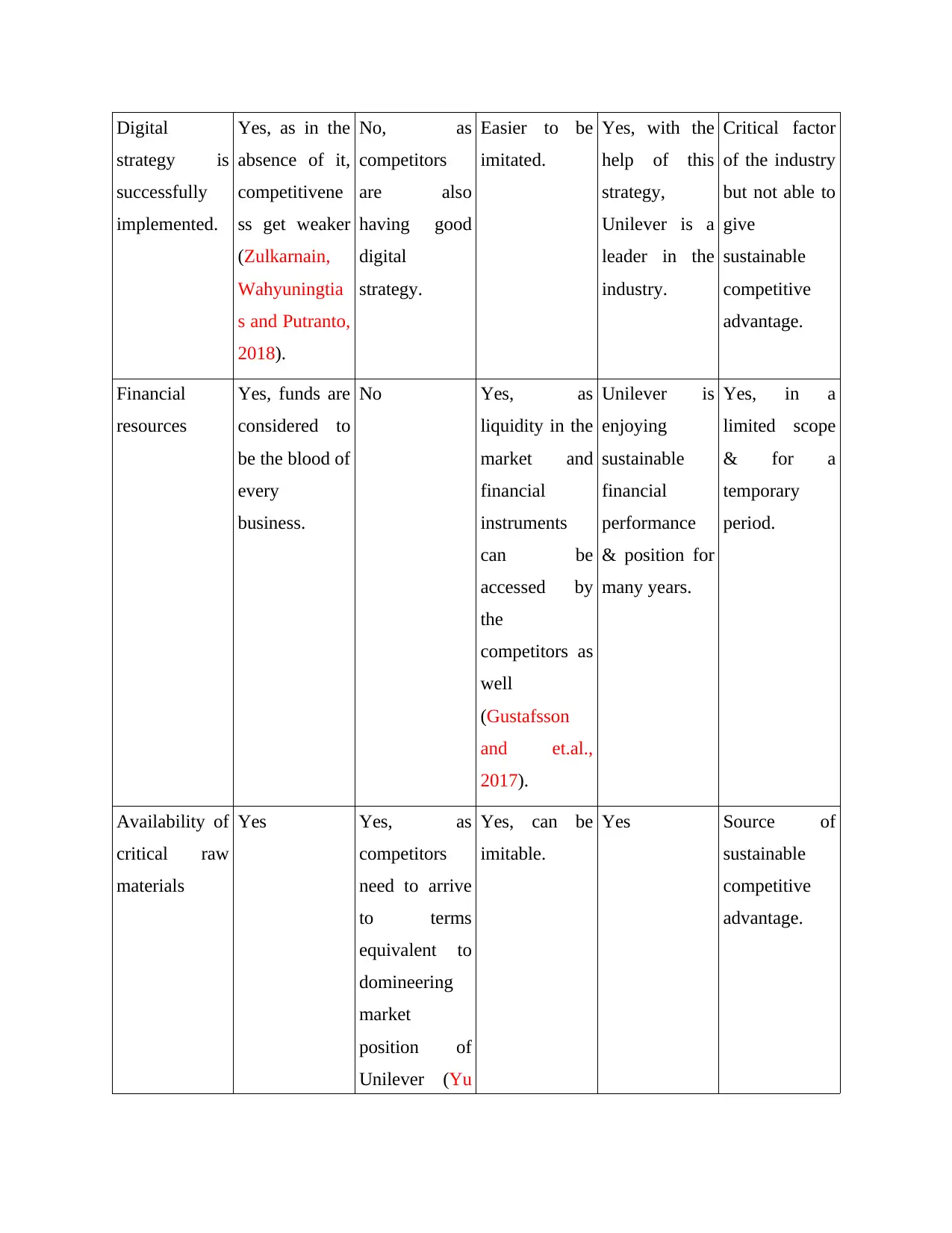
Digital
strategy is
successfully
implemented.
Yes, as in the
absence of it,
competitivene
ss get weaker
(Zulkarnain,
Wahyuningtia
s and Putranto,
2018).
No, as
competitors
are also
having good
digital
strategy.
Easier to be
imitated.
Yes, with the
help of this
strategy,
Unilever is a
leader in the
industry.
Critical factor
of the industry
but not able to
give
sustainable
competitive
advantage.
Financial
resources
Yes, funds are
considered to
be the blood of
every
business.
No Yes, as
liquidity in the
market and
financial
instruments
can be
accessed by
the
competitors as
well
(Gustafsson
and et.al.,
2017).
Unilever is
enjoying
sustainable
financial
performance
& position for
many years.
Yes, in a
limited scope
& for a
temporary
period.
Availability of
critical raw
materials
Yes Yes, as
competitors
need to arrive
to terms
equivalent to
domineering
market
position of
Unilever (Yu
Yes, can be
imitable.
Yes Source of
sustainable
competitive
advantage.
strategy is
successfully
implemented.
Yes, as in the
absence of it,
competitivene
ss get weaker
(Zulkarnain,
Wahyuningtia
s and Putranto,
2018).
No, as
competitors
are also
having good
digital
strategy.
Easier to be
imitated.
Yes, with the
help of this
strategy,
Unilever is a
leader in the
industry.
Critical factor
of the industry
but not able to
give
sustainable
competitive
advantage.
Financial
resources
Yes, funds are
considered to
be the blood of
every
business.
No Yes, as
liquidity in the
market and
financial
instruments
can be
accessed by
the
competitors as
well
(Gustafsson
and et.al.,
2017).
Unilever is
enjoying
sustainable
financial
performance
& position for
many years.
Yes, in a
limited scope
& for a
temporary
period.
Availability of
critical raw
materials
Yes Yes, as
competitors
need to arrive
to terms
equivalent to
domineering
market
position of
Unilever (Yu
Yes, can be
imitable.
Yes Source of
sustainable
competitive
advantage.
Secure Best Marks with AI Grader
Need help grading? Try our AI Grader for instant feedback on your assignments.
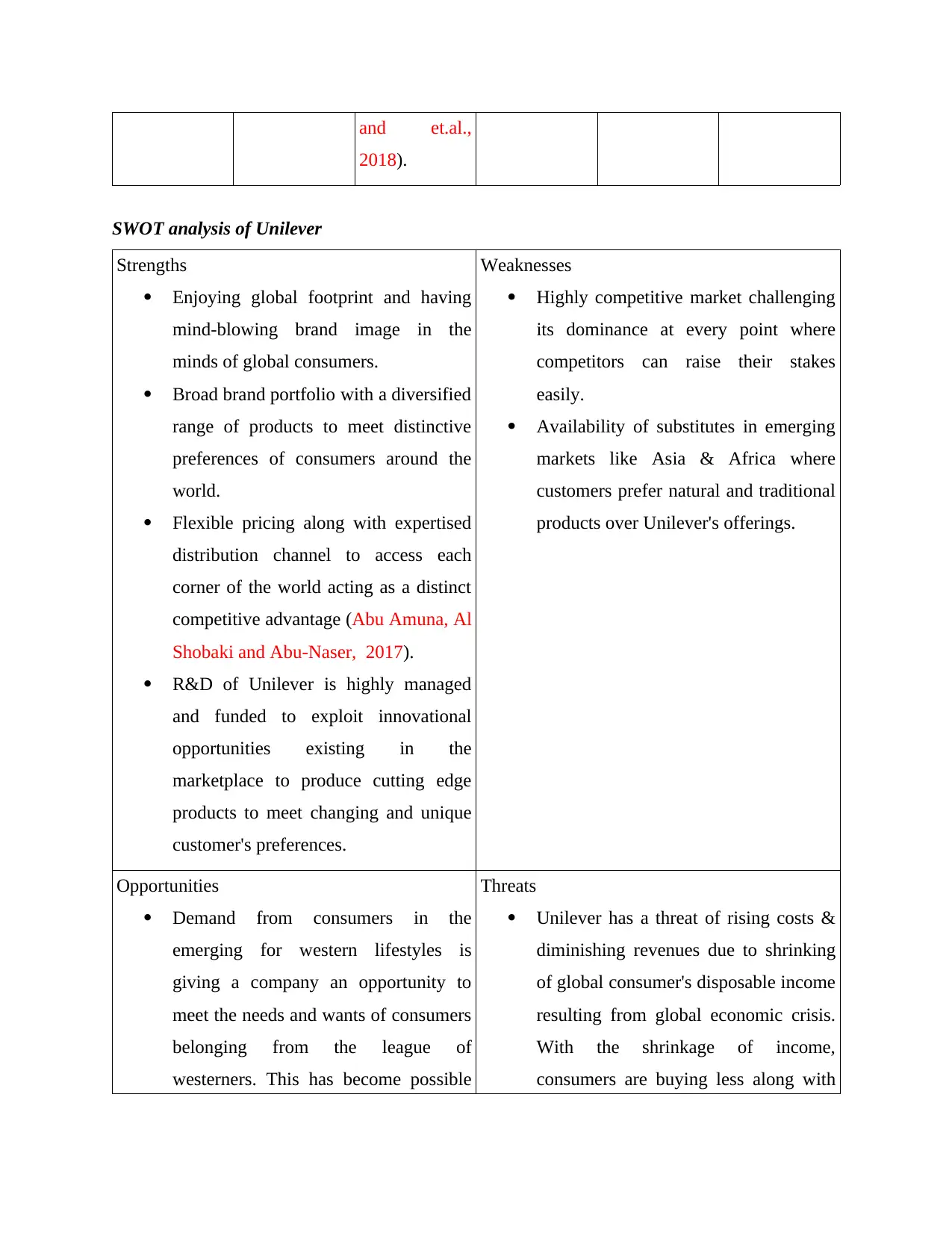
and et.al.,
2018).
SWOT analysis of Unilever
Strengths
Enjoying global footprint and having
mind-blowing brand image in the
minds of global consumers.
Broad brand portfolio with a diversified
range of products to meet distinctive
preferences of consumers around the
world.
Flexible pricing along with expertised
distribution channel to access each
corner of the world acting as a distinct
competitive advantage (Abu Amuna, Al
Shobaki and Abu-Naser, 2017).
R&D of Unilever is highly managed
and funded to exploit innovational
opportunities existing in the
marketplace to produce cutting edge
products to meet changing and unique
customer's preferences.
Weaknesses
Highly competitive market challenging
its dominance at every point where
competitors can raise their stakes
easily.
Availability of substitutes in emerging
markets like Asia & Africa where
customers prefer natural and traditional
products over Unilever's offerings.
Opportunities
Demand from consumers in the
emerging for western lifestyles is
giving a company an opportunity to
meet the needs and wants of consumers
belonging from the league of
westerners. This has become possible
Threats
Unilever has a threat of rising costs &
diminishing revenues due to shrinking
of global consumer's disposable income
resulting from global economic crisis.
With the shrinkage of income,
consumers are buying less along with
2018).
SWOT analysis of Unilever
Strengths
Enjoying global footprint and having
mind-blowing brand image in the
minds of global consumers.
Broad brand portfolio with a diversified
range of products to meet distinctive
preferences of consumers around the
world.
Flexible pricing along with expertised
distribution channel to access each
corner of the world acting as a distinct
competitive advantage (Abu Amuna, Al
Shobaki and Abu-Naser, 2017).
R&D of Unilever is highly managed
and funded to exploit innovational
opportunities existing in the
marketplace to produce cutting edge
products to meet changing and unique
customer's preferences.
Weaknesses
Highly competitive market challenging
its dominance at every point where
competitors can raise their stakes
easily.
Availability of substitutes in emerging
markets like Asia & Africa where
customers prefer natural and traditional
products over Unilever's offerings.
Opportunities
Demand from consumers in the
emerging for western lifestyles is
giving a company an opportunity to
meet the needs and wants of consumers
belonging from the league of
westerners. This has become possible
Threats
Unilever has a threat of rising costs &
diminishing revenues due to shrinking
of global consumer's disposable income
resulting from global economic crisis.
With the shrinkage of income,
consumers are buying less along with
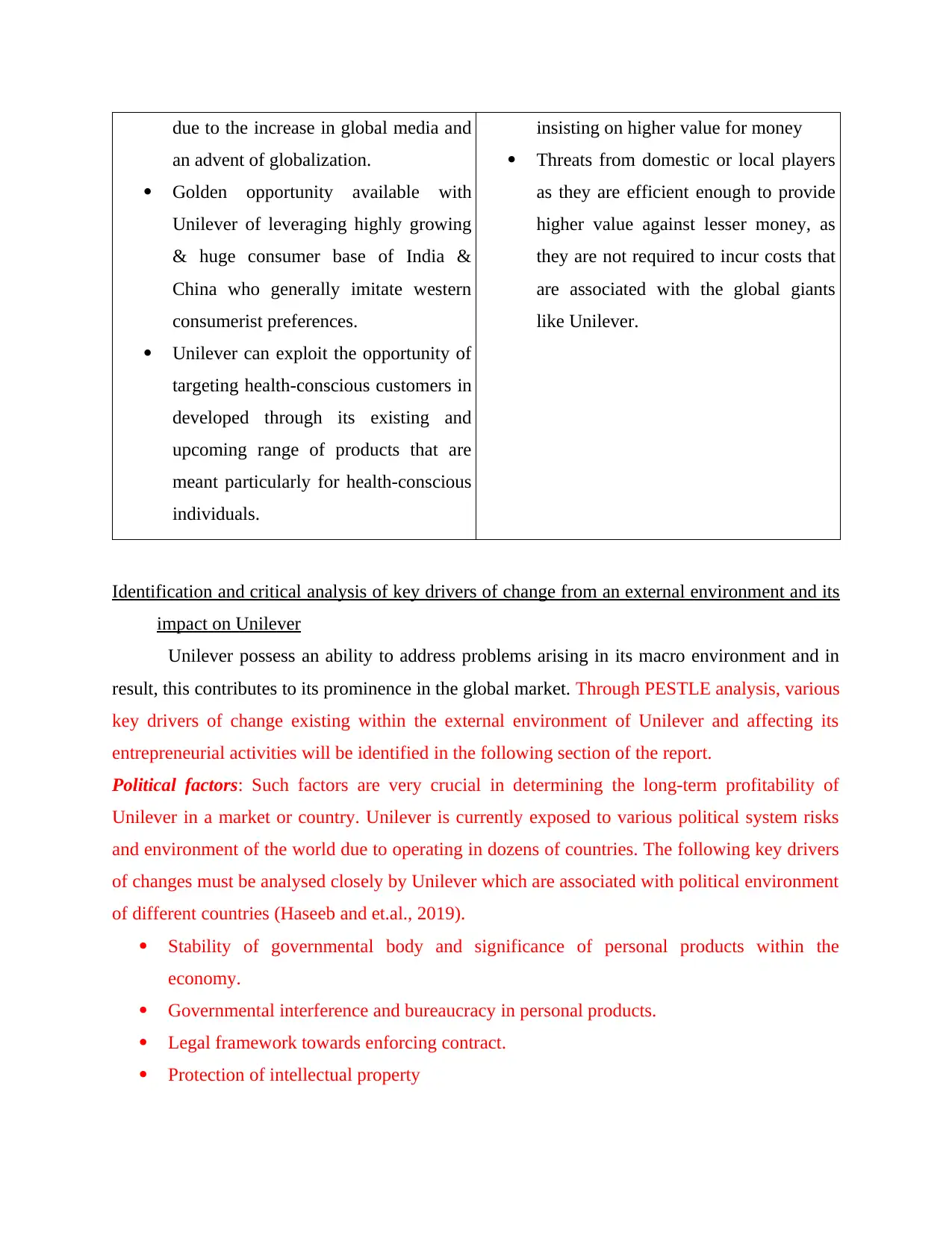
due to the increase in global media and
an advent of globalization.
Golden opportunity available with
Unilever of leveraging highly growing
& huge consumer base of India &
China who generally imitate western
consumerist preferences.
Unilever can exploit the opportunity of
targeting health-conscious customers in
developed through its existing and
upcoming range of products that are
meant particularly for health-conscious
individuals.
insisting on higher value for money
Threats from domestic or local players
as they are efficient enough to provide
higher value against lesser money, as
they are not required to incur costs that
are associated with the global giants
like Unilever.
Identification and critical analysis of key drivers of change from an external environment and its
impact on Unilever
Unilever possess an ability to address problems arising in its macro environment and in
result, this contributes to its prominence in the global market. Through PESTLE analysis, various
key drivers of change existing within the external environment of Unilever and affecting its
entrepreneurial activities will be identified in the following section of the report.
Political factors: Such factors are very crucial in determining the long-term profitability of
Unilever in a market or country. Unilever is currently exposed to various political system risks
and environment of the world due to operating in dozens of countries. The following key drivers
of changes must be analysed closely by Unilever which are associated with political environment
of different countries (Haseeb and et.al., 2019).
Stability of governmental body and significance of personal products within the
economy.
Governmental interference and bureaucracy in personal products.
Legal framework towards enforcing contract.
Protection of intellectual property
an advent of globalization.
Golden opportunity available with
Unilever of leveraging highly growing
& huge consumer base of India &
China who generally imitate western
consumerist preferences.
Unilever can exploit the opportunity of
targeting health-conscious customers in
developed through its existing and
upcoming range of products that are
meant particularly for health-conscious
individuals.
insisting on higher value for money
Threats from domestic or local players
as they are efficient enough to provide
higher value against lesser money, as
they are not required to incur costs that
are associated with the global giants
like Unilever.
Identification and critical analysis of key drivers of change from an external environment and its
impact on Unilever
Unilever possess an ability to address problems arising in its macro environment and in
result, this contributes to its prominence in the global market. Through PESTLE analysis, various
key drivers of change existing within the external environment of Unilever and affecting its
entrepreneurial activities will be identified in the following section of the report.
Political factors: Such factors are very crucial in determining the long-term profitability of
Unilever in a market or country. Unilever is currently exposed to various political system risks
and environment of the world due to operating in dozens of countries. The following key drivers
of changes must be analysed closely by Unilever which are associated with political environment
of different countries (Haseeb and et.al., 2019).
Stability of governmental body and significance of personal products within the
economy.
Governmental interference and bureaucracy in personal products.
Legal framework towards enforcing contract.
Protection of intellectual property
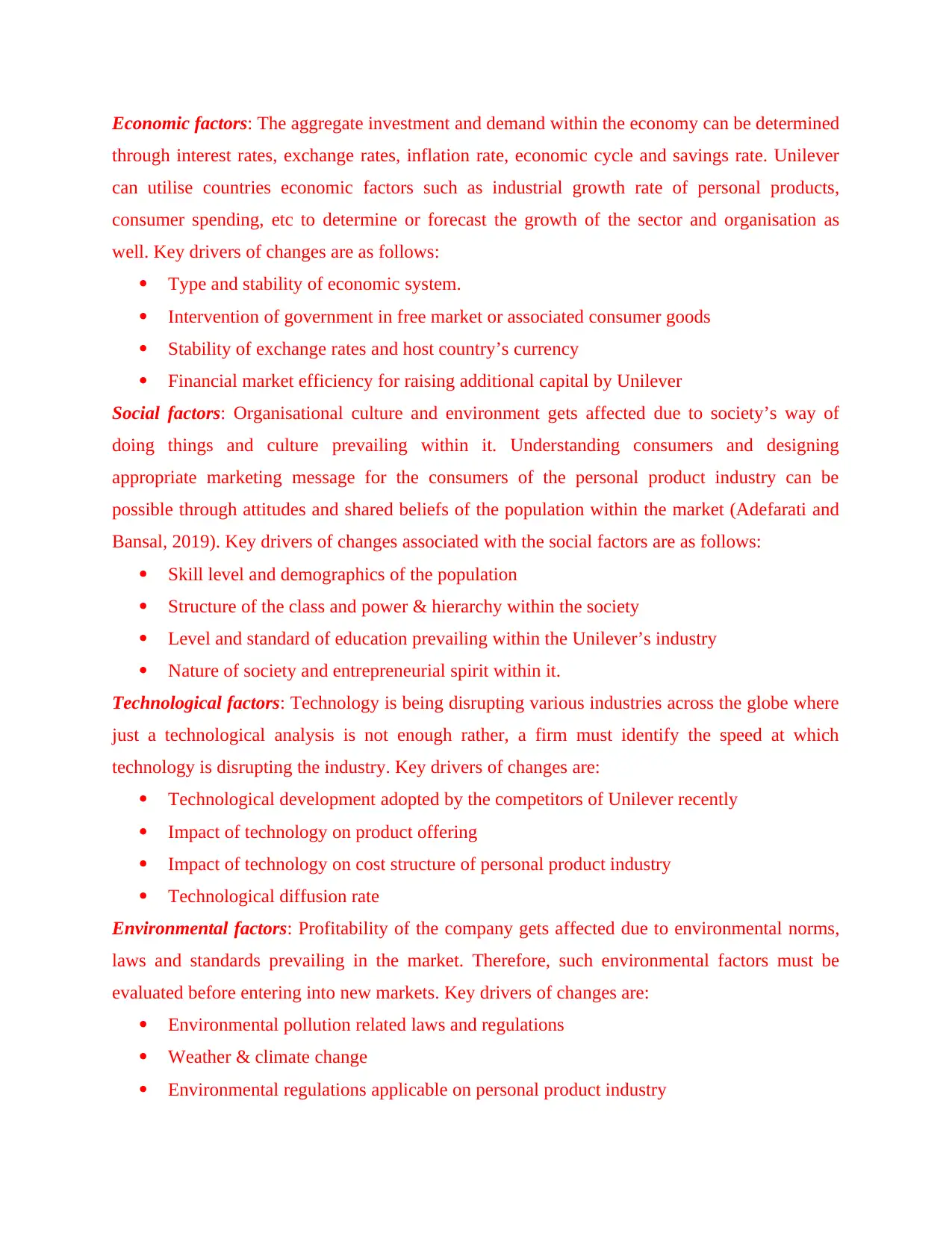
Economic factors: The aggregate investment and demand within the economy can be determined
through interest rates, exchange rates, inflation rate, economic cycle and savings rate. Unilever
can utilise countries economic factors such as industrial growth rate of personal products,
consumer spending, etc to determine or forecast the growth of the sector and organisation as
well. Key drivers of changes are as follows:
Type and stability of economic system.
Intervention of government in free market or associated consumer goods
Stability of exchange rates and host country’s currency
Financial market efficiency for raising additional capital by Unilever
Social factors: Organisational culture and environment gets affected due to society’s way of
doing things and culture prevailing within it. Understanding consumers and designing
appropriate marketing message for the consumers of the personal product industry can be
possible through attitudes and shared beliefs of the population within the market (Adefarati and
Bansal, 2019). Key drivers of changes associated with the social factors are as follows:
Skill level and demographics of the population
Structure of the class and power & hierarchy within the society
Level and standard of education prevailing within the Unilever’s industry
Nature of society and entrepreneurial spirit within it.
Technological factors: Technology is being disrupting various industries across the globe where
just a technological analysis is not enough rather, a firm must identify the speed at which
technology is disrupting the industry. Key drivers of changes are:
Technological development adopted by the competitors of Unilever recently
Impact of technology on product offering
Impact of technology on cost structure of personal product industry
Technological diffusion rate
Environmental factors: Profitability of the company gets affected due to environmental norms,
laws and standards prevailing in the market. Therefore, such environmental factors must be
evaluated before entering into new markets. Key drivers of changes are:
Environmental pollution related laws and regulations
Weather & climate change
Environmental regulations applicable on personal product industry
through interest rates, exchange rates, inflation rate, economic cycle and savings rate. Unilever
can utilise countries economic factors such as industrial growth rate of personal products,
consumer spending, etc to determine or forecast the growth of the sector and organisation as
well. Key drivers of changes are as follows:
Type and stability of economic system.
Intervention of government in free market or associated consumer goods
Stability of exchange rates and host country’s currency
Financial market efficiency for raising additional capital by Unilever
Social factors: Organisational culture and environment gets affected due to society’s way of
doing things and culture prevailing within it. Understanding consumers and designing
appropriate marketing message for the consumers of the personal product industry can be
possible through attitudes and shared beliefs of the population within the market (Adefarati and
Bansal, 2019). Key drivers of changes associated with the social factors are as follows:
Skill level and demographics of the population
Structure of the class and power & hierarchy within the society
Level and standard of education prevailing within the Unilever’s industry
Nature of society and entrepreneurial spirit within it.
Technological factors: Technology is being disrupting various industries across the globe where
just a technological analysis is not enough rather, a firm must identify the speed at which
technology is disrupting the industry. Key drivers of changes are:
Technological development adopted by the competitors of Unilever recently
Impact of technology on product offering
Impact of technology on cost structure of personal product industry
Technological diffusion rate
Environmental factors: Profitability of the company gets affected due to environmental norms,
laws and standards prevailing in the market. Therefore, such environmental factors must be
evaluated before entering into new markets. Key drivers of changes are:
Environmental pollution related laws and regulations
Weather & climate change
Environmental regulations applicable on personal product industry
Paraphrase This Document
Need a fresh take? Get an instant paraphrase of this document with our AI Paraphraser
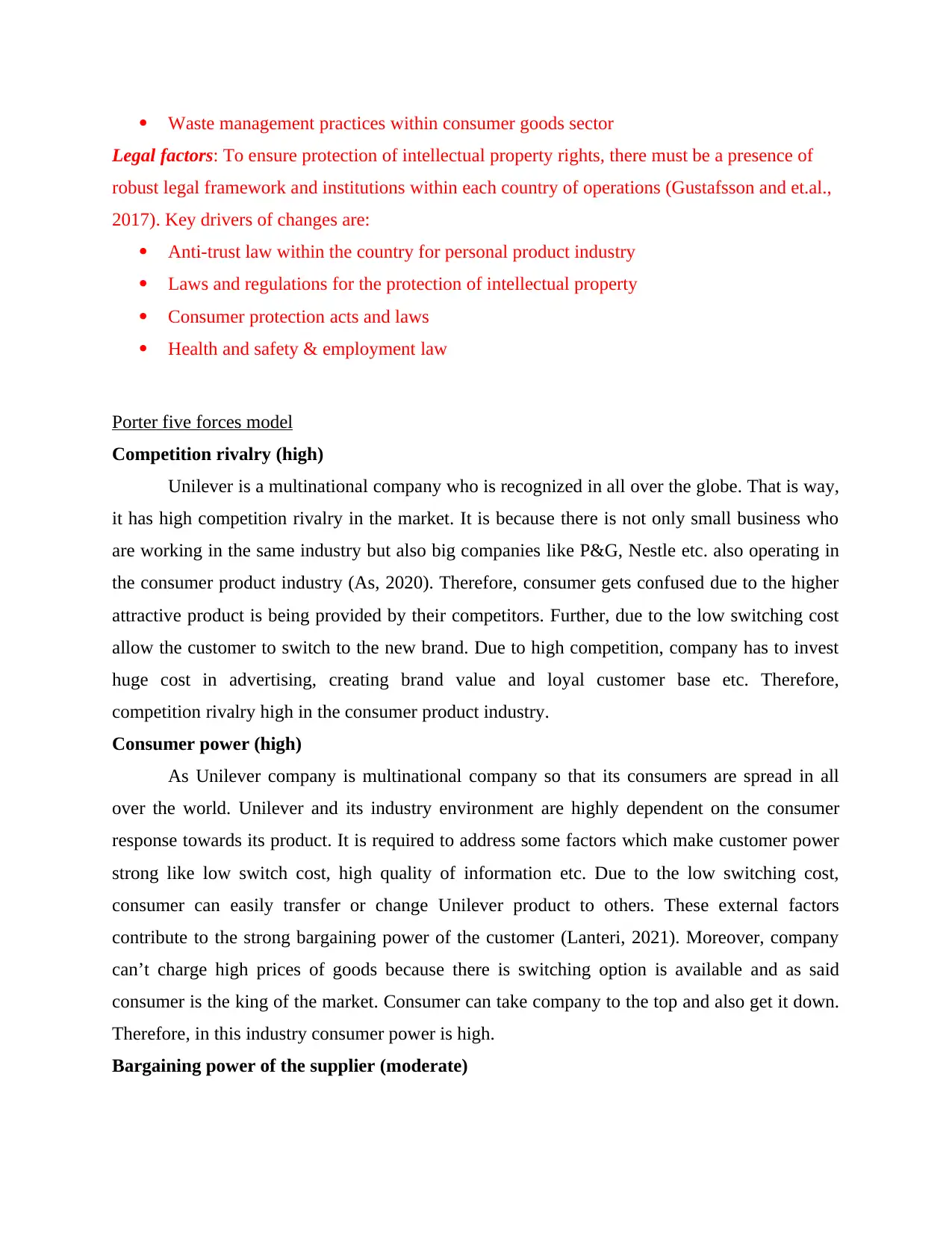
Waste management practices within consumer goods sector
Legal factors: To ensure protection of intellectual property rights, there must be a presence of
robust legal framework and institutions within each country of operations (Gustafsson and et.al.,
2017). Key drivers of changes are:
Anti-trust law within the country for personal product industry
Laws and regulations for the protection of intellectual property
Consumer protection acts and laws
Health and safety & employment law
Porter five forces model
Competition rivalry (high)
Unilever is a multinational company who is recognized in all over the globe. That is way,
it has high competition rivalry in the market. It is because there is not only small business who
are working in the same industry but also big companies like P&G, Nestle etc. also operating in
the consumer product industry (As, 2020). Therefore, consumer gets confused due to the higher
attractive product is being provided by their competitors. Further, due to the low switching cost
allow the customer to switch to the new brand. Due to high competition, company has to invest
huge cost in advertising, creating brand value and loyal customer base etc. Therefore,
competition rivalry high in the consumer product industry.
Consumer power (high)
As Unilever company is multinational company so that its consumers are spread in all
over the world. Unilever and its industry environment are highly dependent on the consumer
response towards its product. It is required to address some factors which make customer power
strong like low switch cost, high quality of information etc. Due to the low switching cost,
consumer can easily transfer or change Unilever product to others. These external factors
contribute to the strong bargaining power of the customer (Lanteri, 2021). Moreover, company
can’t charge high prices of goods because there is switching option is available and as said
consumer is the king of the market. Consumer can take company to the top and also get it down.
Therefore, in this industry consumer power is high.
Bargaining power of the supplier (moderate)
Legal factors: To ensure protection of intellectual property rights, there must be a presence of
robust legal framework and institutions within each country of operations (Gustafsson and et.al.,
2017). Key drivers of changes are:
Anti-trust law within the country for personal product industry
Laws and regulations for the protection of intellectual property
Consumer protection acts and laws
Health and safety & employment law
Porter five forces model
Competition rivalry (high)
Unilever is a multinational company who is recognized in all over the globe. That is way,
it has high competition rivalry in the market. It is because there is not only small business who
are working in the same industry but also big companies like P&G, Nestle etc. also operating in
the consumer product industry (As, 2020). Therefore, consumer gets confused due to the higher
attractive product is being provided by their competitors. Further, due to the low switching cost
allow the customer to switch to the new brand. Due to high competition, company has to invest
huge cost in advertising, creating brand value and loyal customer base etc. Therefore,
competition rivalry high in the consumer product industry.
Consumer power (high)
As Unilever company is multinational company so that its consumers are spread in all
over the world. Unilever and its industry environment are highly dependent on the consumer
response towards its product. It is required to address some factors which make customer power
strong like low switch cost, high quality of information etc. Due to the low switching cost,
consumer can easily transfer or change Unilever product to others. These external factors
contribute to the strong bargaining power of the customer (Lanteri, 2021). Moreover, company
can’t charge high prices of goods because there is switching option is available and as said
consumer is the king of the market. Consumer can take company to the top and also get it down.
Therefore, in this industry consumer power is high.
Bargaining power of the supplier (moderate)
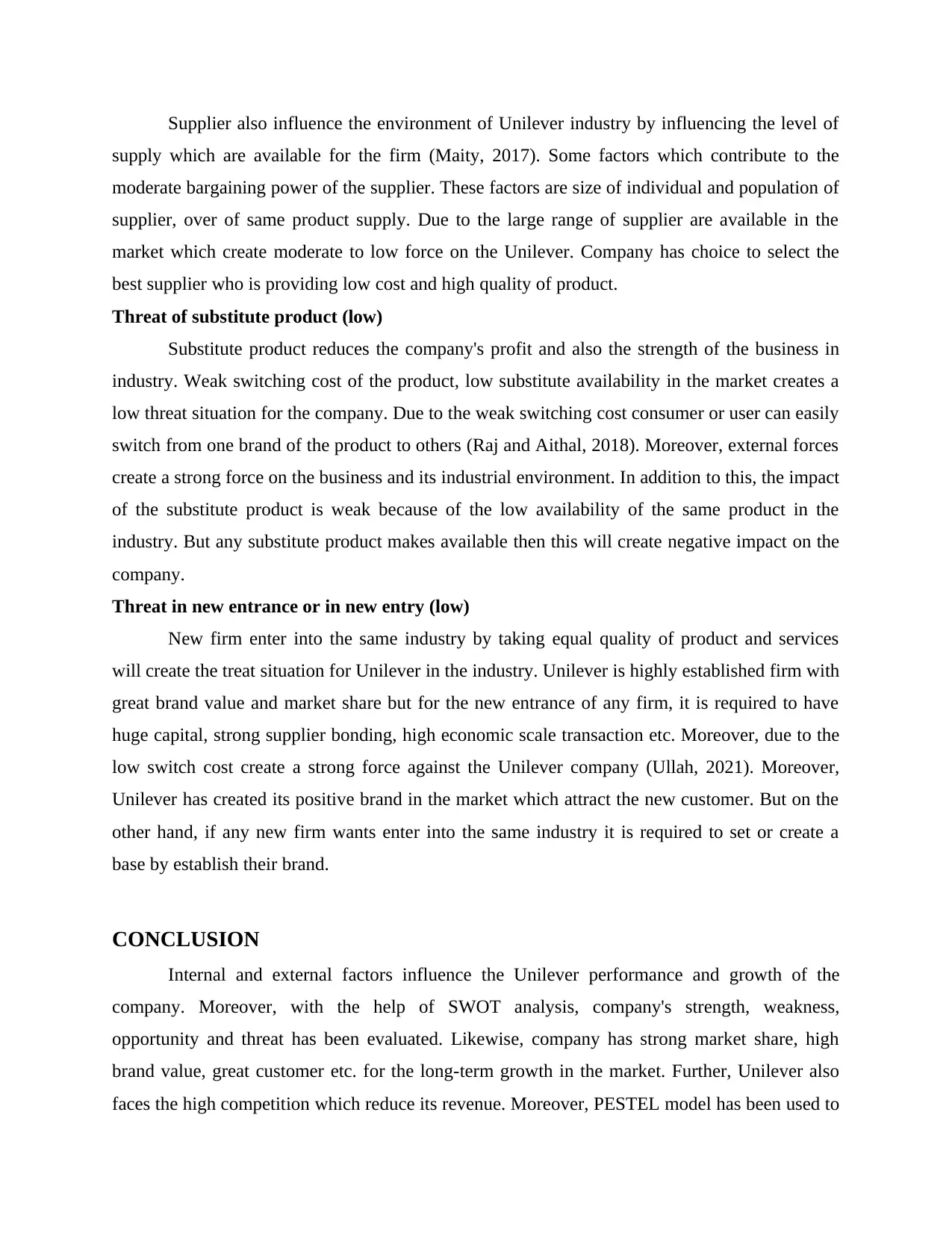
Supplier also influence the environment of Unilever industry by influencing the level of
supply which are available for the firm (Maity, 2017). Some factors which contribute to the
moderate bargaining power of the supplier. These factors are size of individual and population of
supplier, over of same product supply. Due to the large range of supplier are available in the
market which create moderate to low force on the Unilever. Company has choice to select the
best supplier who is providing low cost and high quality of product.
Threat of substitute product (low)
Substitute product reduces the company's profit and also the strength of the business in
industry. Weak switching cost of the product, low substitute availability in the market creates a
low threat situation for the company. Due to the weak switching cost consumer or user can easily
switch from one brand of the product to others (Raj and Aithal, 2018). Moreover, external forces
create a strong force on the business and its industrial environment. In addition to this, the impact
of the substitute product is weak because of the low availability of the same product in the
industry. But any substitute product makes available then this will create negative impact on the
company.
Threat in new entrance or in new entry (low)
New firm enter into the same industry by taking equal quality of product and services
will create the treat situation for Unilever in the industry. Unilever is highly established firm with
great brand value and market share but for the new entrance of any firm, it is required to have
huge capital, strong supplier bonding, high economic scale transaction etc. Moreover, due to the
low switch cost create a strong force against the Unilever company (Ullah, 2021). Moreover,
Unilever has created its positive brand in the market which attract the new customer. But on the
other hand, if any new firm wants enter into the same industry it is required to set or create a
base by establish their brand.
CONCLUSION
Internal and external factors influence the Unilever performance and growth of the
company. Moreover, with the help of SWOT analysis, company's strength, weakness,
opportunity and threat has been evaluated. Likewise, company has strong market share, high
brand value, great customer etc. for the long-term growth in the market. Further, Unilever also
faces the high competition which reduce its revenue. Moreover, PESTEL model has been used to
supply which are available for the firm (Maity, 2017). Some factors which contribute to the
moderate bargaining power of the supplier. These factors are size of individual and population of
supplier, over of same product supply. Due to the large range of supplier are available in the
market which create moderate to low force on the Unilever. Company has choice to select the
best supplier who is providing low cost and high quality of product.
Threat of substitute product (low)
Substitute product reduces the company's profit and also the strength of the business in
industry. Weak switching cost of the product, low substitute availability in the market creates a
low threat situation for the company. Due to the weak switching cost consumer or user can easily
switch from one brand of the product to others (Raj and Aithal, 2018). Moreover, external forces
create a strong force on the business and its industrial environment. In addition to this, the impact
of the substitute product is weak because of the low availability of the same product in the
industry. But any substitute product makes available then this will create negative impact on the
company.
Threat in new entrance or in new entry (low)
New firm enter into the same industry by taking equal quality of product and services
will create the treat situation for Unilever in the industry. Unilever is highly established firm with
great brand value and market share but for the new entrance of any firm, it is required to have
huge capital, strong supplier bonding, high economic scale transaction etc. Moreover, due to the
low switch cost create a strong force against the Unilever company (Ullah, 2021). Moreover,
Unilever has created its positive brand in the market which attract the new customer. But on the
other hand, if any new firm wants enter into the same industry it is required to set or create a
base by establish their brand.
CONCLUSION
Internal and external factors influence the Unilever performance and growth of the
company. Moreover, with the help of SWOT analysis, company's strength, weakness,
opportunity and threat has been evaluated. Likewise, company has strong market share, high
brand value, great customer etc. for the long-term growth in the market. Further, Unilever also
faces the high competition which reduce its revenue. Moreover, PESTEL model has been used to
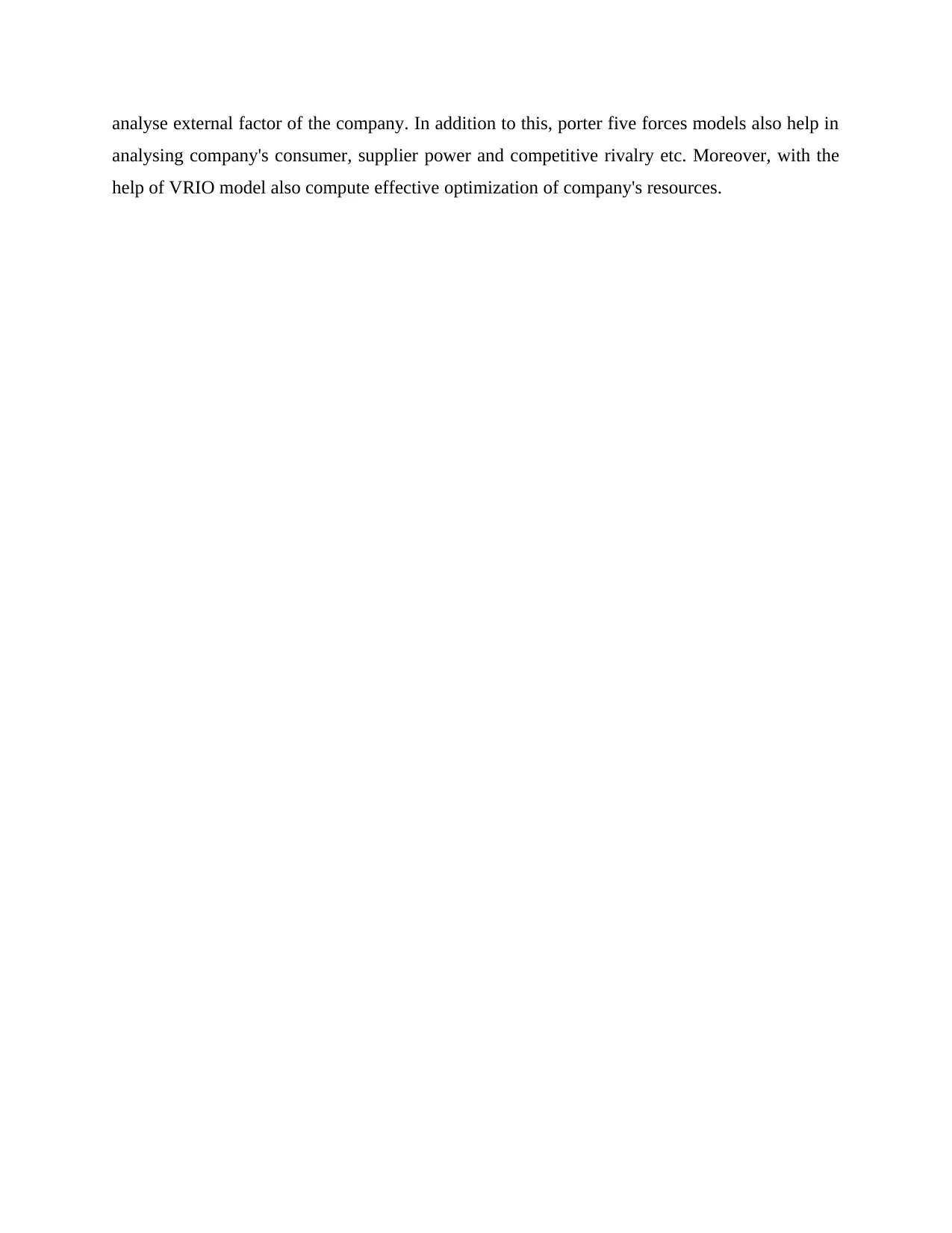
analyse external factor of the company. In addition to this, porter five forces models also help in
analysing company's consumer, supplier power and competitive rivalry etc. Moreover, with the
help of VRIO model also compute effective optimization of company's resources.
analysing company's consumer, supplier power and competitive rivalry etc. Moreover, with the
help of VRIO model also compute effective optimization of company's resources.
Secure Best Marks with AI Grader
Need help grading? Try our AI Grader for instant feedback on your assignments.
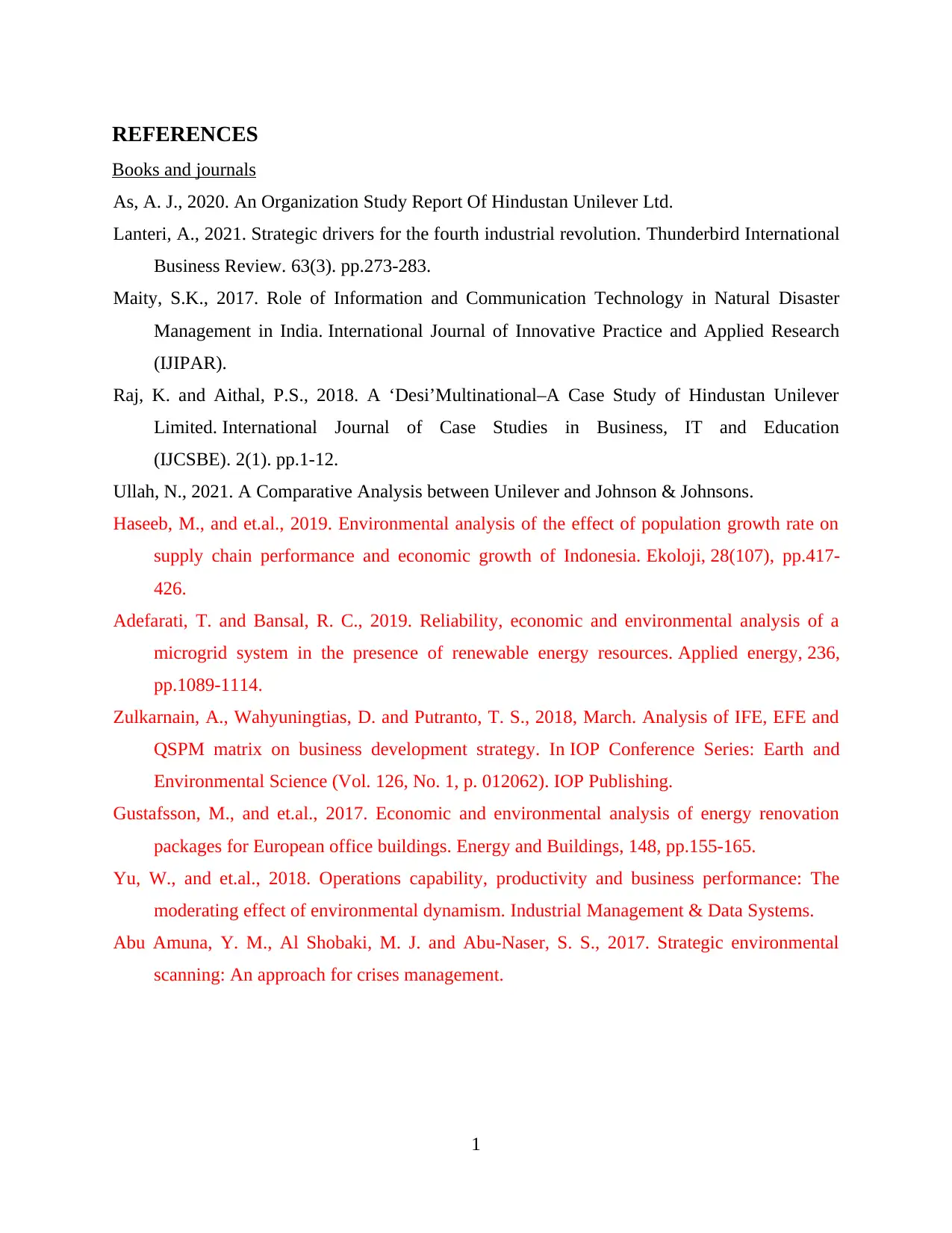
REFERENCES
Books and journals
As, A. J., 2020. An Organization Study Report Of Hindustan Unilever Ltd.
Lanteri, A., 2021. Strategic drivers for the fourth industrial revolution. Thunderbird International
Business Review. 63(3). pp.273-283.
Maity, S.K., 2017. Role of Information and Communication Technology in Natural Disaster
Management in India. International Journal of Innovative Practice and Applied Research
(IJIPAR).
Raj, K. and Aithal, P.S., 2018. A ‘Desi’Multinational–A Case Study of Hindustan Unilever
Limited. International Journal of Case Studies in Business, IT and Education
(IJCSBE). 2(1). pp.1-12.
Ullah, N., 2021. A Comparative Analysis between Unilever and Johnson & Johnsons.
Haseeb, M., and et.al., 2019. Environmental analysis of the effect of population growth rate on
supply chain performance and economic growth of Indonesia. Ekoloji, 28(107), pp.417-
426.
Adefarati, T. and Bansal, R. C., 2019. Reliability, economic and environmental analysis of a
microgrid system in the presence of renewable energy resources. Applied energy, 236,
pp.1089-1114.
Zulkarnain, A., Wahyuningtias, D. and Putranto, T. S., 2018, March. Analysis of IFE, EFE and
QSPM matrix on business development strategy. In IOP Conference Series: Earth and
Environmental Science (Vol. 126, No. 1, p. 012062). IOP Publishing.
Gustafsson, M., and et.al., 2017. Economic and environmental analysis of energy renovation
packages for European office buildings. Energy and Buildings, 148, pp.155-165.
Yu, W., and et.al., 2018. Operations capability, productivity and business performance: The
moderating effect of environmental dynamism. Industrial Management & Data Systems.
Abu Amuna, Y. M., Al Shobaki, M. J. and Abu-Naser, S. S., 2017. Strategic environmental
scanning: An approach for crises management.
1
Books and journals
As, A. J., 2020. An Organization Study Report Of Hindustan Unilever Ltd.
Lanteri, A., 2021. Strategic drivers for the fourth industrial revolution. Thunderbird International
Business Review. 63(3). pp.273-283.
Maity, S.K., 2017. Role of Information and Communication Technology in Natural Disaster
Management in India. International Journal of Innovative Practice and Applied Research
(IJIPAR).
Raj, K. and Aithal, P.S., 2018. A ‘Desi’Multinational–A Case Study of Hindustan Unilever
Limited. International Journal of Case Studies in Business, IT and Education
(IJCSBE). 2(1). pp.1-12.
Ullah, N., 2021. A Comparative Analysis between Unilever and Johnson & Johnsons.
Haseeb, M., and et.al., 2019. Environmental analysis of the effect of population growth rate on
supply chain performance and economic growth of Indonesia. Ekoloji, 28(107), pp.417-
426.
Adefarati, T. and Bansal, R. C., 2019. Reliability, economic and environmental analysis of a
microgrid system in the presence of renewable energy resources. Applied energy, 236,
pp.1089-1114.
Zulkarnain, A., Wahyuningtias, D. and Putranto, T. S., 2018, March. Analysis of IFE, EFE and
QSPM matrix on business development strategy. In IOP Conference Series: Earth and
Environmental Science (Vol. 126, No. 1, p. 012062). IOP Publishing.
Gustafsson, M., and et.al., 2017. Economic and environmental analysis of energy renovation
packages for European office buildings. Energy and Buildings, 148, pp.155-165.
Yu, W., and et.al., 2018. Operations capability, productivity and business performance: The
moderating effect of environmental dynamism. Industrial Management & Data Systems.
Abu Amuna, Y. M., Al Shobaki, M. J. and Abu-Naser, S. S., 2017. Strategic environmental
scanning: An approach for crises management.
1
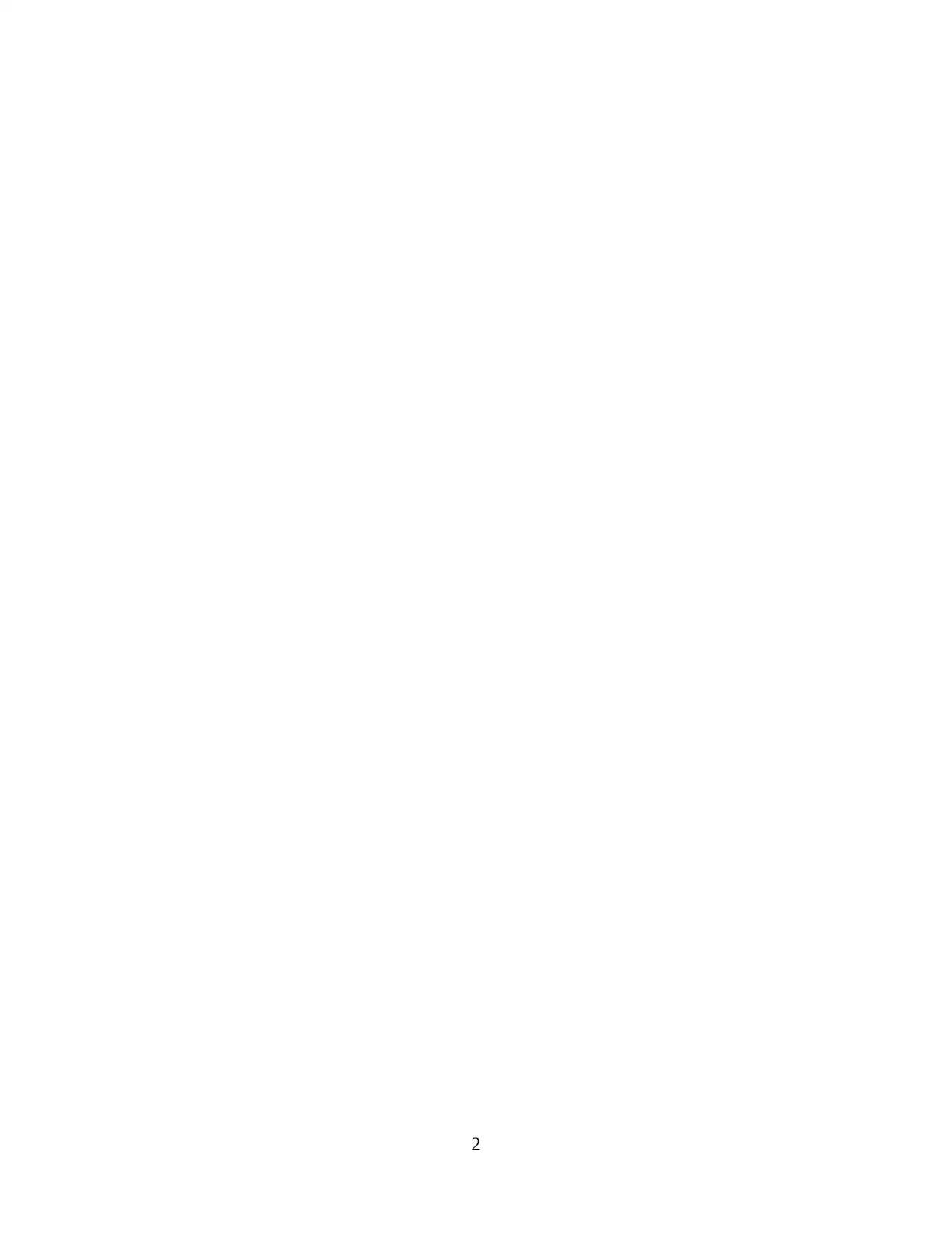
2
1 out of 12
Related Documents
Your All-in-One AI-Powered Toolkit for Academic Success.
+13062052269
info@desklib.com
Available 24*7 on WhatsApp / Email
![[object Object]](/_next/static/media/star-bottom.7253800d.svg)
Unlock your academic potential
© 2024 | Zucol Services PVT LTD | All rights reserved.





